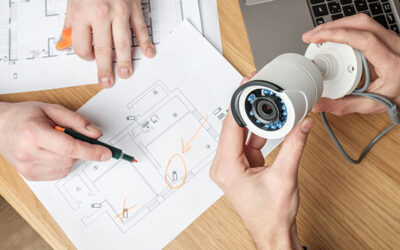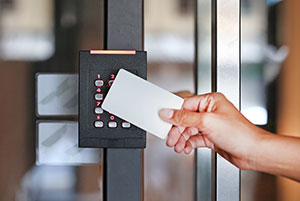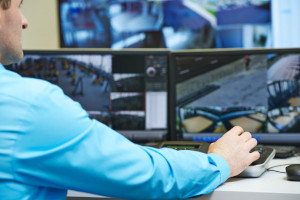When security cameras were first released to the public, they cost so much that they were out of reach for everyone but the largest businesses and the wealthiest individuals. Today, advancements in technology have brought the price of surveillance equipment down to the point where everyone can afford to install them to better secure their home or business.
However, this has created another issue, albeit a positive one – consumers are spoilt for choice! There are so many great security cameras on the market, to suit every budget, that it choosing the right one can be overwhelming.
To help you feel more confident when shopping around for the camera that suits you best, this post takes you through the main things you need to consider when selecting the most suitable security camera.
What Do I Need to Know Before Buying a Security Camera?
First things first, before you decide on a security camera, you need to know what’s on offer and what distinguishes a particular camera from another. Then you can match those features to your security needs. Here are a few things to look out for.
Resolution
First, and perhaps Most importantly, is your camera’s resolution, which determines the quality of your recorded image and video footage. Security cameras come in a variety of resolutions, including.
- 720p
- 1080p (2mp)
- 1140p (4mp)
- 1920p (5mp)
- 2160p (8mp & 12mp/4K)
However, the most common resolution you will come across is 1080p & 4K. In general, the higher the resolution, the better the footage – but the higher the price too.
Night Vision
Another important consideration is if you’ll need security cameras with night vision capabilities. The more outdoor areas you have surrounding your property, the more use you have for need night vision. In real-time, you’ll be better able to see anyone approaching your home or business when it’s dark, and in the event a crime takes place, you’ll have an easier time identifying the culprits from the footage.
Functionality
It’s important for your security camera to both have the functionality you need to protect your property – and for those features to work as intended and be easy to use.
Firstly, which features are you looking for, and why? Second, how well does that feature perform, compared to the manufacturer’s claims?
A great example of this is motion detection: a commonly-desired feature as it helps the property owner determine when something out of the ordinary is happening in their home or business premises, like the presence of an intruder on site. However, if the security camera’s motion sensors are too sensitive, they could constantly pepper the owner with annoying notifications – and record unneeded footage. If the sensors aren’t sensitive enough, on the other hand, then the camera may not send notifications or capture footage when it is supposed to.
Reading or watching reviews of the security cameras you’ve got your eye on, on forums and YouTube, respectively, is an excellent way to discover how well they work. Alternatively, give us a quick call and we’ll be happy to help you assess a camera’s suitability for your security needs and the type and size of your property.
A Solid App Experience
Similarly, if your security camera of choice can be viewed and controlled via an app, what’s that app like? What features does it offer? Again, you can do a little research and find out from other users’ reviews if it’s all it’s cracked up to be. It may claim to have heaps of features, but do they actually work? Is the app user friendly or overly complicated? Is it stable or does it crash a lot?
Recording Storage
Two main factors determine the type of recording storage you’ll require:
How much footage you plan on recording
The resolution of the cameras you plan on installing
When it comes to how much footage you’re going to record, you then need to consider:
- Recording frequency: do you plan on recording around the clock, at certain times (like through the night), or only when the camera system is triggered (i.e., motion detection)?
- The number of cameras you’ll install: the more cameras you have, the more footage they’ll record and the more space you’ll need.
With camera resolution, meanwhile, the higher it is, the more space the footage will take up on a storage device – so the more storage you’ll need.
When you know that, you’ll have a far clearer idea of whether you’ll need an SD card, for small amounts of footage; or a network video recorder (NVR)/digital video recorder (DVR) or cloud storage, for larger amounts of footage.
Also, you’re by no means restricted to one type of storage, as you may switch to a larger storage method at particular times. A prominent example of this is if you go away on vacation, as you’ll need to ensure you have enough data storage to cover the entirety of your time away – so you may need to switch from an SD card to cloud storage.
Build Quality
Lastly, there’s the quality of the camera’s build, or hardware. This becomes more important if you need to position camera(s) outside. In such a scenario, is the camera sturdy? Can it successfully withstand the elements, like the wind, rain, and sun? Is it tamper-proof? A camera may have a lot of features but it also needs to be sufficiently robust so it’s up to the task of properly protecting your property.
How Do I Choose a Good Security Camera?
Now you know what to bear in mind before buying a security camera, let’s look a little more into choosing a camera that suits you best.
Choose your camera type
First, and most importantly of all, you need to decide on the type of camera you’ll need. Your ideal camera will depend on several factors, such as the size of your property, how much footage you intend to record, the camera’s purpose, and where you intend to position your cameras.
-
Wired vs. Wireless
Would you prefer a wired or wireless security camera? Wired security systems offer the advantage of a constant power source and a persistent connection to a storage device, but you’ll also need to organise and hide the wiring so it’s not a hazard (not to mention an eyesore).
Wireless security cameras do away with the cables but you’re dependent on a consistent Wi-Fi connection. Plus, if you want it to be truly wireless, will have to frequently check on and change the batteries that power it.
-
Monitored vs. Self-monitored
Do you intend on monitoring your security footage and, by extension, watching over your property, yourself – or would you prefer a professional security company do it on your behalf? Self-monitoring is more cost-effective, if you’re on a tighter budget, but you’ll then need to choose a security camera with an excellent remote viewing app. Also, ideally, you’ll need reliable and accurate motion detection capabilities so you’re sent notifications when something on your property requires your attention.
With a monitored system, also known as back to base monitoring, the most ideal arrangement is to have a digital security alarm system to instantly trigger various sirens and support the activations of your CCTV system. Your property will be under constant surveillance by trained security professionals. Not only does this mean that you won’t have to watch over your home or business yourself but you won’t be forced to act quickly and decisively in the event of an incident. Instead, the security personnel monitoring your property will send a patrol to investigate – and will contact the authorities on your behalf, if need be.
-
Video Doorbells
A video doorbell is a great option for recording what’s happening at your front door. While limited, they still act as an effective deterrent – particularly if your main purpose for installing a security camera is preventing the theft of packages from your porch. Also, many video doorbells come with two-way audio capabilities so you can talk to the person on your porch – which includes letting a potential perpetrator know that you can see them! Plus, they’re easy to set up and run on low-voltage wiring, giving them a simple and steady power source.
-
Floodlight & Ai Cameras
A floodlight or Ai camera combines the deterrent capabilities of security cameras and motion-activated lighting. So, not only will the lights automatically turn on when someone approaches your property but the camera will start recording them too. Better still, some floodlight cameras come equipped with sirens and/or two-way audio, as an extra auditory deterrent.
Pick Your Power Source
As well as where you’re going to position each camera, you’ll need to work out how you’re going to power each camera: with your options being a power adapter, CAT5 cable or batteries. With an adapter or CAT5 cable, you’ll have a constant power source but you’ll also have wires. With batteries, meanwhile, you do away with wires, but at the expense of reliability.
Really, your required power source depends on how much footage you intend to record & the restriction of getting cable to the device. If you want to record constantly, there’s no getting around the need for power. But if you only want to record footage when the camera is triggered, then you can make use of a battery-powered security camera.
Compare Cloud Storage Plans
This ties back into our discussion of how much footage you intend to record and, subsequently, where you intend to store said footage recorded by your cameras. If you plan on recording a lot and, more importantly, if you want to install a wireless security system, then you’ll need a cloud storage plan.
Fortunately, some security camera manufacturers will offer cloud storage subscriptions when you purchase one of their cameras. It’s then up to you to weigh up their offering with the quality of their cameras and their features.
How Do You Determine How Many Security Cameras I Need?
Ok, so now you’ve considered your camera’s quality, it’s time to think about quantity: how many security cameras will you need. This will depend on several factors, including:
- Purpose: First off, what you’ll be doing with the cameras will help determine how many you need. If you need them to deter burglars from entering your home, for instance, you’ll need fewer cameras than if you want to carefully want to monitor your employees and customers at your business. Determining the cameras’ purpose gets you thinking about where they need to go and what they’re going to be looking at – which helps you decide how many you need.
- The Size of Your Property: The size of your home or business premises is another significant factor in how many cameras you’ll need. Naturally, the bigger your property, the more cameras you’re likely to require.
As a general rule, 3-4 cameras are a great start for most homes, comprised of:
- 2 outdoor cameras, covering the front and back of the house
- 1-2 indoor cameras, to watch children, elderly relatives, pets, and valuables.
You can then add cameras to particular rooms that need extra surveillance or external areas, such as sheds and garages. Most of our clients opt for 4 external cameras around each side of their home.
- Type of Cameras: The high-quality the cameras and the better positioned they are, the fewer you can get away with having installed. This is especially true of wide-angle lenses that provide a greater field of view, because they cover a larger area.
Is 1080p Good Enough for Security Cameras?
At the start of this post, we looked at resolution, 1080p being the most common resolution you’re likely to come across.
The 1080 represent the number of vertical pixels (p) in an image. This determines how much the image picture can be enlarged without becoming blurred or distorted. In short, the higher the resolution, the larger the image and the more detail it’ll have when you zoom in. 1080p is known as full HD.
But, the question is, is 1080p good enough for recording security footage? Here are a few scenarios where 1080p is sufficient.
- Smaller Homes and Offices: 1080p cameras are good enough small, well-lit spaces. This is because the scene captured by the camera will be small enough to make out any people within it.
- Video Doorbells: as someone at your front door will be looking directly into the camera, a 1080p camera is more than sufficient for making out their facial features. However, it helps if your porch is well-lit at night, so coupling a doorbell camera with some motion-activated lights is a great combination.
- Hidden Cameras: concealed cameras at ground level, such as those tucked away in a specially designed wall or digital clock, can recognize people as there generally won’t be much distance between them.
While footage recorded with 1080p cameras is fine for many people in most circumstances, technological advancements mean that upgrades to 4K cameras don’t cost much more. Though it’s worth remembering that they do require more storage and internet bandwidth.
Summary
We hope this post has educated you on how to select the best security camera for your home or business. If you’d like some help choosing the ideal security camera for your situation – or want a full, complimentary security assessment to get a better idea of your security needs as a whole, please get in touch and we’ll be thrilled to assist you.




